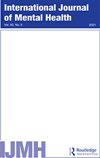Prevalence and correlates of suicidal ideation in a sample of urban Haiti residents
IF 1.7
Q3 PSYCHOLOGY, CLINICAL
引用次数: 0
Abstract
AbstractThere is a dearth of scientific knowledge regarding suicidal ideation (SI) and adverse childhood experiences (ACEs) in Haiti. We conducted a community survey with a convenience sample of 673 residents from Haiti’s Cité Soleil (January - June 2021) to address these gaps. Participants answered questions on SI, on ACEs from the ACE international questionnaire (ACE-IQ) section 5 abuse-related items, on adult experiences of non-partner sexual violence, on use of alcohol to manage stress and on trauma responses. Latent Class Analysis identified a five-class-model of poly-victimization ranging from Class 1 (no abuse) to Class 5 (combination of emotional, physical, and sexual abuse). SI prevalence was 65.3%. Women were nearly twice as likely as men to report SI (95% CI = 1.08–2.74). Class 1 comprised 25% of participants. Class 5 members were almost four times more likely to endorse SI than Class 1 members (95% CI = 1.52–9.10). Class 4 members were roughly four times more likely to endorse SI than Class 1 members. (95% CL = 1.83–7.81). Class 3 members were nearly twice as likely to endorse SI as Class 1 members (95% CI = 1.03–3.35). Participant survivors of NPSV were three times more likely to report SI than non-victims (95% CI = 1.61–5.67). Alcohol use to manage stress increased odds of SI by 1.59 (95% CI = 1.01–2.52). Hypervigilance increased the odds of SI by 3.21 (95% CI = 1.84–5.58). Limitations include recall bias, non-generalizability, use of self-reported data, and ACE-IQ’s limitations.Early identification and prevention of SI, ACE, NPSV, alcohol use, and trauma are warranted.Keywords: Haitisuicidal ideationadverse childhood experiencesinterpersonal violencenon-partner sexual violence Disclosure statementNo potential conflict of interest was reported by the author(s)海地城市居民自杀意念的流行及其相关因素
摘要关于海地自杀意念(SI)和不良童年经历(ace)的科学知识缺乏。我们在2021年1月至6月期间对海地cit Soleil的673名居民进行了一项社区调查,以解决这些差距。与会者回答了以下问题:SI、ACE国际调查问卷(ACE- iq)第5节与虐待有关的ACE、成人遭受非伴侣性暴力的经历、使用酒精来控制压力以及创伤反应。潜在类别分析确定了一个五类多重受害模型,从第一类(无虐待)到第五类(情感、身体和性虐待的结合)。SI患病率为65.3%。女性报告SI的可能性几乎是男性的两倍(95% CI = 1.08-2.74)。1班占参与者的25%。第5类成员支持SI的可能性几乎是第1类成员的4倍(95% CI = 1.52-9.10)。第4类成员支持SI的可能性大约是第1类成员的4倍。(95% cl = 1.83 ~ 7.81)。第三类成员支持SI的可能性几乎是第一类成员的两倍(95% CI = 1.03-3.35)。NPSV幸存者报告SI的可能性是非受害者的三倍(95% CI = 1.61-5.67)。使用酒精来控制压力会使SI的几率增加1.59 (95% CI = 1.01-2.52)。过度警惕使SI的几率增加3.21 (95% CI = 1.84-5.58)。局限性包括回忆偏差、非泛化性、使用自我报告数据和ACE-IQ的局限性。早期识别和预防SI、ACE、NPSV、酒精使用和创伤是必要的。关键词:海地自杀意念童年不良经历人际暴力非伴侣性暴力披露声明作者未报告潜在利益冲突
本文章由计算机程序翻译,如有差异,请以英文原文为准。
求助全文
约1分钟内获得全文
求助全文
来源期刊

INTERNATIONAL JOURNAL OF MENTAL HEALTH
PSYCHOLOGY, CLINICAL-
CiteScore
3.80
自引率
20.00%
发文量
32
期刊介绍:
The official journal of the World Association for Psychosocial Rehabilitation, the International Journal of Mental Health features in-depth articles on research, clinical practice, and the organization and delivery of mental health services around the world. Covering both developed and developing countries, it provides vital information on important new ideas and trends in community mental health, social psychiatry, psychiatric epidemiology, prevention, treatment, and psychosocial rehabilitation.
 求助内容:
求助内容: 应助结果提醒方式:
应助结果提醒方式:


